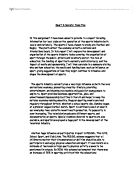These were privately owned schools and there were only 9 of them around the country. They were established in the 1864 Clarendon report.
Most schoolmasters at this time strongly believed that sport was a waste of time and distracting. It was actively discouraged by most because it was alleged to encourage unhealthy indiscriminate and riotous behaviour; such as drinking, gambling and violence.
There was hereafter a class divide, which decided that sport was not appropriate for future Gentlemen; “Football is only suitable for butcher’s boys” (said the Butler of Shrewsbury)
The preliminary period of public schools had a slight influence on the development of sport. It began to deal with the problem of order and organisation by introducing individual rules. The fact that schools had individual rules meant that there couldn’t any inter-schools competitions because the rules that each team played by varied from school to school. Following these teams began to step up the regularity of play thus improving all round performance, but due to the fact that they only used local rules games only went ahead internally.
It wasn’t until about the 1840’s that Public schools began to change and generate more influence and involvement in sport. One of the main leaders in the direction of athleticism was Rugby school, which was one of the Clarendon schools.
The Head there Thomas Arnold can be remembered as one of a number of Headmasters who established an environment that eventually stimulated athleticism.
Arnold endeavoured to create social control and moral reform through sport. It was important to him to create Christian Gentlemen; form a “manly piety”.
It was believed that he used sport as he thought it was morally good although it can be argued that it was due to his love for sport as Wymer (1953) suggested that Arnold did in fact have a love for several sports; such as cricket, mountain-walking, swimming, sailing, shooting, and riding.
However it is clear that the original sporting enthusiasm came entirely from the boy’s. Arnold’s astute nature sensed their enthusiasm and thus acted upon it to achieve moral and social reforms.
Sport became a useful social feature, in later schools one of the main objectives of the Housemaster was to ensure that the boys were beneficially occupied; this was often done by arranging sporting competitions.
The Headmaster in G.E.L Cotton introduced sport and games to Marlborough in 1852, his main motive was to create discipline to gain control of over wild sports such as poaching. He did this by organising games, improving sporting facilities and most importantly appointing fervent games teacher/masters.
As sport became increasingly popular with both the boys and their Master’s the influence of the progressive Headmasters became increasingly valuable.
The localised rules, which the boys had been taught at their previous schools, travelled with them to Oxford and Cambridge Universities. It was there that a “melting pot” was developed as the students supplied their diverse interpretations of different games. This was the ultimate catalyst for sport.
During the 20 years following Arnold there were immense transformations made. School staff now actively agreed and supported sport in schools rather than just recognising it. There was an indisputable aspiration to develop excellence in a wide range of sports and identify the most elite and talented performers.
It was this cohort of teachers that took athleticism to a new level. They carried it in to the “Muscular Christian” era.
The introduction of new schools and the expansion of existing schools led to an immense project; the building of new sporting facilities including gymnasiums and extensive playing fields.
The structure of the school day was also altered. The morning consisted of academic studies, the afternoon was sporting activities and the evening was prep and house activities.
Public school athleticism has had an enormous influence on the maturity of sport through history. Sport was brought on substantially in the course of the last 20 years or so of the 1800’s. The time spent on playing sport could be up to five hours a day and it was coached by professionals and elite individuals. This inevitably created a widespread model of play that caused the standard of amateur sport to reach levels it had never seen before.
Sport became an essential part of education meaning that its importance was vast. People respected, valued and enjoyed sport. The physical endeavour and moral integrity that sport carried with it become a crucial part of life.
The concept of athleticism created not only a new standard of physical ability and sporting performance but also a new model of Gentlemen with superior moral values and social control.







